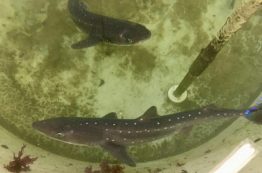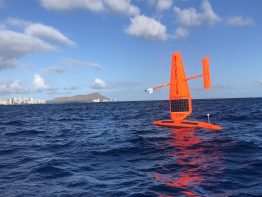Contrary to what popular media portrays, we actually don’t know much about what sharks eat. Even less is known about how they digest their food, and the role they play in the larger ocean ecosystem. For more than a century, researchers have relied on flat sketches of sharks’ digestive systems to discern how they function — and how what they eat and excrete impacts other species in the ocean.
Read more at UW News »Remotely-piloted sailboats monitor ‘cold pools’ in tropical environments
Conditions in the tropical ocean affect weather patterns worldwide. The most well-known examples are El Niño or La Niña events, but scientists believe other key elements of the tropical climate remain undiscovered. In a study recently published in Geophysical Research Letters, scientists from the University of Washington and NOAA’s Pacific Marine Environmental Laboratory use remotely-piloted sailboats to gather data on cold air pools, or pockets of cooler air that form below tropical storm clouds.
Read more at UW News »Researchers discover yessotoxins, produced by certain phytoplankton, to be a culprit behind summer mass shellfish mortality events in Washington
Back in the summers of 2018 and 2019, the shellfish industry in Washington state was rocked by mass mortalities of its crops. “It was oysters, clams, cockles — all bivalve species in some bays were impacted,” said Teri King, aquaculture and marine water quality specialist at Washington Sea Grant based at the University of Washington. “They were dying, and nobody knew why.”
Read more at UW News »Endangered blue whales recorded off southwest coast of India
Research from the University of Washington shows that endangered blue whales are present and singing off the southwest coast of India. The results suggest that conservation measures should include this region, which is considering expanding tourism. Analysis of recordings from late 2018 to early 2020 in Lakshadweep, an archipelago of 36 low-lying islands west of the Indian state of Kerala, detected whales with a peak activity in April and May.
Read more at UW News »Thousands of baby sea stars born at UW lab are sign of hope for endangered species
Just a few days shy of the first day of spring, scientists at Friday Harbor Laboratories on San Juan Island had reason to celebrate. Dozens of juvenile sea stars, no bigger than a poppy seed, had successfully metamorphosed from floating larvae to mini star — the important first step toward becoming an adult. Between now and then, these sunflower sea stars, the largest sea star species in the world, will grow up to 24 arms and a colorful body the size of a serving platter.
Read more at UW News »





